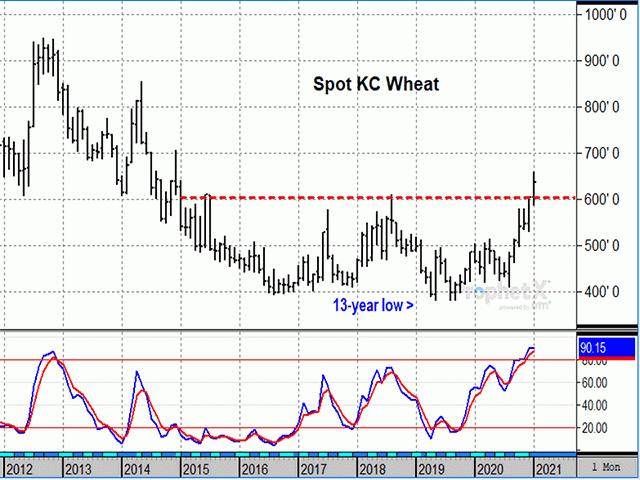Todd's Take
Does KC Wheat Deserve More Than $6.00?
It was just four months ago when this column looked at KC wheat and talked about how unusual it was for prices to start showing bullish behavior after just completing a second year of record global wheat production and also facing a record level of world ending wheat stocks in 2020-21 (read that column, "HRW Wheat Ignores the Bearish Talk" here: (https://www.dtnpf.com/…).
At the time, I explained the importance of being skeptical about world estimates of grain supplies and pointed to Sept. 16, 2020, as a day when the market's focus switched from dwelling on the bearish past to starting to be concerned about dry weather conditions for the next winter wheat crop -- a crop that was just being planted.
The future is a funny thing as it often doesn't give a hoot about the past. That seems to be the case for KC wheat prices at the start of 2021. Forget the record production in 2020; forget the record ending wheat stocks, if there ever were any; and forget the past six years of prices sulking between $4.00 and $6.00 a bushel. This is a new day ... or is it?
Since that September article, there have been a few new developments to note. Wheat in southern Russia received a few light rains later that fall but remained unusually dry as crops went dormant. Here in the U.S., drought in the western Plains has gotten worse. The Climate Prediction Center's latest U.S. Seasonal Drought Outlook expects various levels of drought will remain entrenched in the western U.S. Plains until at least the end of April.
P[L1] D[0x0] M[300x250] OOP[F] ADUNIT[] T[]
The most interesting news lately comes from Russia, the world's largest exporter of wheat. According to USDA, Russia will have a surplus of 12.53 million metric tons (mmt) or 460 million bushels (mb) in 2020-21, the highest in 10 years. Russia's government, however, recently announced it was concerned about diminishing supplies and rising prices at home, and enacted a wheat export tax of 25 euros per metric ton to take effect Feb. 15, followed by a higher tax of 50 euros per metric ton on March 1. At today's exchange rate, the first tax is the equivalent of 83 cents per bushel, raised to $1.65 a bushel on March. 1.
Given the new stiff taxes, it is fair to say that Russia doesn't have as large of a wheat excess as USDA estimates, just as China probably doesn't have the surplus corn or wheat USDA estimates for them.
As corroborating evidence, Russia's FOB wheat price for 12.5% protein at Black Sea ports was quoted at $298.50 per metric ton (mt) on Thursday's close (Jan. 21), the equivalent of $8.12 a bushel and near its highest in several years. Similarly, common wheat on China's Zhengzhou exchange settled at the equivalent of $11.08 per bushel Thursday (Jan. 21). Both prices support notions wheat supplies are tighter than normal.
Here in the U.S., USDA's estimate of 836 mb of ending wheat stocks for 2020-21 justifies cash hard red winter (HRW) wheat prices near $4.90 a bushel, but doesn't explain Thursday's spot close of $6.35 3/4 per bushel. If we expected lower supplies in Russia and China to lead to more export business for the U.S., there is not much evidence of that. U.S. wheat export sales commitments are up 8% from this time a year ago, but actual exports are down 1%.
But there is a lot more to consider for wheat prices than the fundamentals of 2020-21. Corn at $5.00 is one strong argument for $6.00 wheat prices, especially while U.S. soybean supplies remain tight. The potential for drought this spring in Russia, Ukraine and the U.S. are also viable bullish scenarios that we can't rule out yet.
Until we learn more about the weather in 2021, wheat prices are apt to stay where they're at. The monthly chart of spot KC wheat shows a long-term technical breakout and we shouldn't forget that Russia's and China's wheat supplies are tighter than previously advertised -- two bullish coincidences that could have long-term impact.
If we relearned anything from 2020, it was the old lesson that life is full of surprises. After six years of depressed wheat prices, it feels strange to talk about wheat's bullish potential above $6.00, but it is legitimate. I can't help but wonder what else we're going to learn in the next four months.
DTN subscribers can check DTN's Six Factors Strategies to see our latest recommendations for winter wheat producers.
Todd Hultman can be reached at Todd.Hultman@dtn.com
Follow him on Twitter @ToddHultman1
(c) Copyright 2021 DTN, LLC. All rights reserved.




